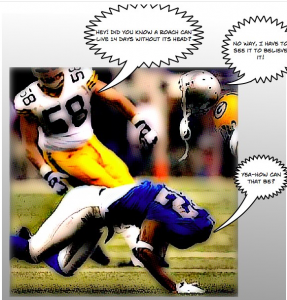 Have you ever heard that one before? It’s been around for awhile and although estimates vary from 9 days to a month most agree that 14 days is the average time a roach could live without its head. Oh and by the way, that headless roach won’t die because he lost his noggin. He dies because of starvation.
Have you ever heard that one before? It’s been around for awhile and although estimates vary from 9 days to a month most agree that 14 days is the average time a roach could live without its head. Oh and by the way, that headless roach won’t die because he lost his noggin. He dies because of starvation.
(Click the pic to enlarge)
Other roach facts
Roaches can go a week without water and can hold their breath for 40 minutes.
Roaches have 6 legs, but 18 knees.
Roaches spend 75% of there time resting and can fit in cracks as thin as a dime.
Roaches run 3 miles per hour and make up to 25 body turns in a second.
Roaches are mainly nocturnal and use there antenna to find there way, sense air currents, smells and chemicals. If their antenna are damaged they can still maneuver using their eyesight and legs to sense objects.
(short antennas on a roach means he will stay near the walls)Roaches also have ‘cerci’ which is antenna like appendage on their hind ends. The cerci have sensitive hairs that pick up air currents and send the information to 14 different nerves. That’s why it’s so hard to squish one with the stomp of your foot.
Roaches can withstand 105,000 rems (rem is a measurement of radiation) which is the equivalent of a thermonuclear explosion.
Humans can only stand about 800.Roaches orient themselves with a magnetic compass of sorts.
Roaches are a relative of termites because both can digest cellulose. (wood)
Under stress such as a lack of males, females can produce young on their own in a process called parthenogenesis. In some species the female only needs to mate once and she can produce babies her entire life.
Female roaches prefer to mate with the less dominant males as this tends to produce more females. Also the tough guys are a little rough and often injure the female during this time.
Cockroach castes or skins produce allergic reactions and trigger asthmatic symptoms especially in poor living conditions.
Roaches have been on earth for 350 million years and are considered the most successful creature ever.




